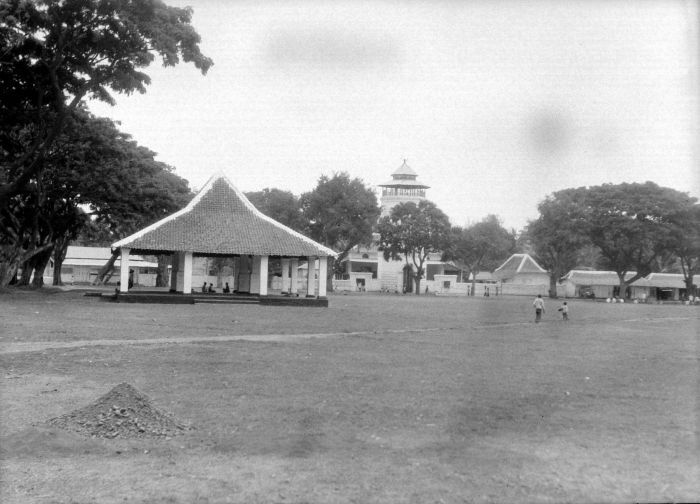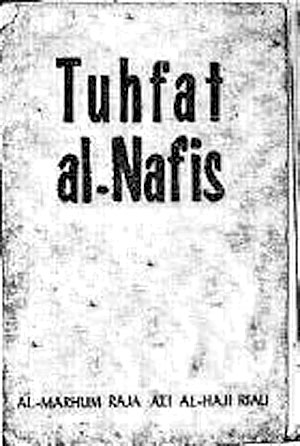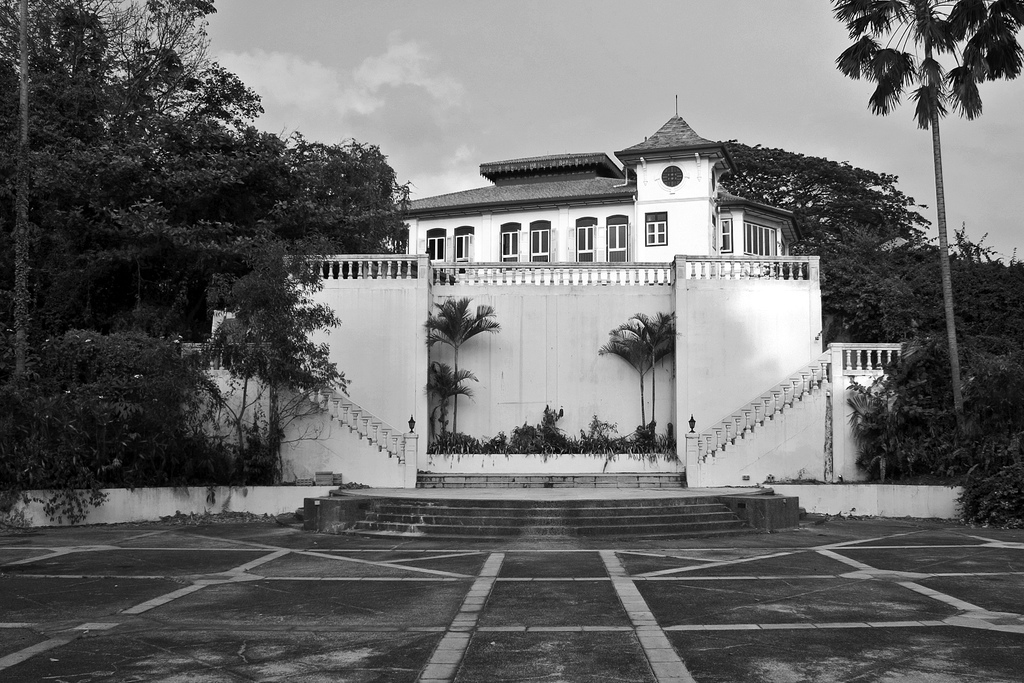|
Abdullah Al-Misri
Abdullah al-Misri (b. late 18th century – d. early 19th century) was an Arab-Malay writer. He had first hand experience of how when the Dutch East India Company went bankrupt in 1799, broad changes happened such as when its possessions were taken over by the Dutch Crown, resulting in massive political change. The Dutch enterprise in Indonesia changed from a mercantile enterprise into a colonial state. Background Born in Palembang, Sumatra, his family were originally from Kedah. His ancestors were from Ottoman-ruled Egypt which meant he was dissimilar to most creoles who were of Hadrami descent. According to the ''Tuhfat al-Nafis'', he was close to the creole Hadramis, especially the al-''kadris'' and rulers of Pontianak. In the early 19th century he was at a time in Besuki, East Java. His cousin Shaykh Abdurrahman, was the maternal grandfather of Usman bin Yahya, an important Islamic scholar of Indonesia. Writings His writings closely quotes the Quran. One of his works w ... [...More Info...] [...Related Items...] OR: [Wikipedia] [Google] [Baidu] |
Dutch East India Company
The United East India Company ( nl, Verenigde Oostindische Compagnie, the VOC) was a chartered company established on the 20th March 1602 by the States General of the Netherlands amalgamating existing companies into the first joint-stock company in the world, granting it a 21-year monopoly to carry out trade activities in Asia. Shares in the company could be bought by any resident of the United Provinces and then subsequently bought and sold in open-air secondary markets (one of which became the Amsterdam Stock Exchange). It is sometimes considered to have been the first multinational corporation. It was a powerful company, possessing quasi-governmental powers, including the ability to wage war, imprison and execute convicts, negotiate treaties, strike its own coins, and establish colonies. They are also known for their international slave trade. Statistically, the VOC eclipsed all of its rivals in the Asia trade. Between 1602 and 1796 the VOC sent almost a million Eur ... [...More Info...] [...Related Items...] OR: [Wikipedia] [Google] [Baidu] |
Besuki
Besuki is the name of a district (''kecamatan'') in Situbondo Regency, East Java, Indonesia with an area of 26.08 km2. In 2004, its population was 57,109 people. In ancient time the city was important because it was the capital of the Residency of Besuki. During Majapahit Kingdom, Besuki was already a growing area and was known by the name Keta. The town revolted along with ''Sadeng'' against the Majapahit Empire but was extinguished by Gajah Mada. This event occurred in the year 1331 CE. Villages # Kalimas # Widoropayung # Bloro # Besuki # Demung The saron is a musical instrument of Indonesia, which is used in the gamelan. It normally has seven bronze bars placed on top of a resonating frame (''rancak''). It is usually about 20 cm (8 in) high, and is played on the floor by a ... # Jetis # Langkap # Pesisir # Blimbing # Sumberejo External links Statistik kecamatan Besuki, Situbondo Districts of East Java Situbondo Regency {{EJava-geo ... [...More Info...] [...Related Items...] OR: [Wikipedia] [Google] [Baidu] |
19th-century Deaths
The 19th (nineteenth) century began on 1 January 1801 ( MDCCCI), and ended on 31 December 1900 ( MCM). The 19th century was the ninth century of the 2nd millennium. The 19th century was characterized by vast social upheaval. Slavery was abolished in much of Europe and the Americas. The First Industrial Revolution, though it began in the late 18th century, expanding beyond its British homeland for the first time during this century, particularly remaking the economies and societies of the Low Countries, the Rhineland, Northern Italy, and the Northeastern United States. A few decades later, the Second Industrial Revolution led to ever more massive urbanization and much higher levels of productivity, profit, and prosperity, a pattern that continued into the 20th century. The Islamic gunpowder empires fell into decline and European imperialism brought much of South Asia, Southeast Asia, and almost all of Africa under colonial rule. It was also marked by the collapse of the l ... [...More Info...] [...Related Items...] OR: [Wikipedia] [Google] [Baidu] |
18th-century Births
The 18th century lasted from January 1, 1701 ( MDCCI) to December 31, 1800 ( MDCCC). During the 18th century, elements of Enlightenment thinking culminated in the American, French, and Haitian Revolutions. During the century, slave trading and human trafficking expanded across the shores of the Atlantic, while declining in Russia, China, and Korea. Revolutions began to challenge the legitimacy of monarchical and aristocratic power structures, including the structures and beliefs that supported slavery. The Industrial Revolution began during mid-century, leading to radical changes in human society and the environment. Western historians have occasionally defined the 18th century otherwise for the purposes of their work. For example, the "short" 18th century may be defined as 1715–1789, denoting the period of time between the death of Louis XIV of France and the start of the French Revolution, with an emphasis on directly interconnected events. To historians who expand ... [...More Info...] [...Related Items...] OR: [Wikipedia] [Google] [Baidu] |
Herman Willem Daendels
Herman Willem Daendels (21 October 1762 – 2 May 1818) was a Dutch revolutionary, general and politician who served as the 36th Governor General of the Dutch East Indies between 1808 and 1811. Early life Born in Hattem, Netherlands, on 21 October 1762, Daendels was the son of Burchard Johan Daendels, the mayoral secretary, and Josina Christina Tulleken. He studied law at the University of Harderwijk, acquiring his doctorate on 10 April 1783. Political activity In 1785, he sided with the Patriots, who had seized power in several Dutch cities. In September 1786 he defended the city of Hattem against stadholderian troops. In September 1787, he defended Amsterdam against the Prussian army that invaded the Netherlands to restore William V of Orange. After William V was in power again, he fled to Pas-de-Calais because of a death sentence. Daendels was a close witness to the French revolution. He returned to the Netherlands in 1794, as a general in the French revolutionary army ... [...More Info...] [...Related Items...] OR: [Wikipedia] [Google] [Baidu] |
Quran
The Quran (, ; Standard Arabic: , Quranic Arabic: , , 'the recitation'), also romanized Qur'an or Koran, is the central religious text of Islam, believed by Muslims to be a revelation from God. It is organized in 114 chapters (pl.: , sing.: ), which consist of verses (pl.: , sing.: , cons.: ). In addition to its religious significance, it is widely regarded as the finest work in Arabic literature, and has significantly influenced the Arabic language. Muslims believe that the Quran was orally revealed by God to the final prophet, Muhammad, through the archangel Gabriel incrementally over a period of some 23 years, beginning in the month of Ramadan, when Muhammad was 40; and concluding in 632, the year of his death. Muslims regard the Quran as Muhammad's most important miracle; a proof of his prophethood; and the culmination of a series of divine messages starting with those revealed to Adam, including the Torah, the Psalms and the Gospel. The word ''Quran'' occurs some ... [...More Info...] [...Related Items...] OR: [Wikipedia] [Google] [Baidu] |
Usman Bin Yahya
Usman bin Yahya, Utsman ibn Yahya or Othman bin Yahya ( ar-at, عثمان بن يحيى , ‘Uthmān bin Yahyā; full name: ( ar-at, سيد عثمان بن عبد الله بن عقيل بن يحيى العلوي, Sayyid ‘Uthmān ibn ‘Abdallāh ibn ‘Aqīl ibn Yaḥyā al-‘Alawī) 1822 CE/17 Rabi' al-awwal 1238 AH – 1913 CE/21 Safar 1331 AH) was an Islamic scholar who served as Grand Mufti of Batavia in 19th century of Dutch East Indies. History Habib Uthman bin Yahya was born in Pekojan, Batavia in 1822 CE (17 Rabi' al-awwal 1238 AH). Uthman came from the Ba 'Alawi sada family from his father, Sayyid Abdullah bin Aqil bin Umar bin Yahya. His mother was Aminah, a daughter of Shaykh Abdurrahman, who was the cousin to the scholar Abdullah al-Misri. His father, Abdullah, and his grandfather, Aqil, were born in Mecca Mecca (; officially Makkah al-Mukarramah, commonly shortened to Makkah ()) is a city and administrative center of the Mecca Province of Saud ... [...More Info...] [...Related Items...] OR: [Wikipedia] [Google] [Baidu] |
East Java
East Java ( id, Jawa Timur) is a province of Indonesia located in the easternmost hemisphere of Java island. It has a land border only with the province of Central Java to the west; the Java Sea and the Indian Ocean border its northern and southern coasts, respectively, while the narrow Bali Strait to the east separates Java from Bali by around . Located in eastern Java, the province also includes the island of Madura (which is connected to Java by the longest bridge in Indonesia, the Suramadu Bridge), as well as the Kangean islands and other smaller island groups located further east (in the northern Bali Sea) and Masalembu archipelagos in the north. Its capital is Surabaya, the second largest city in Indonesia, a major industrial center and also a major business center. Banyuwangi is the largest regency in East Java and the largest on the island of Java. The province covers an area of , and according to the 2010 Census, there were 37,476,757 people residing in the ... [...More Info...] [...Related Items...] OR: [Wikipedia] [Google] [Baidu] |
Pontianak Sultanate
The Pontianak Sultanate ( Malay: كسلطانن ڤونتيناك, ''Kesultanan Pontianak'') was an Islamic Malay state that existed on the western coast of the island of Borneo from the late 18th century until its disestablishment in 1950. The Sultanate was located at the mouth of the Kapuas river in what is today the Indonesian province of West Kalimantan, and the Sultan's residential palace was situated in what later grew to become the modern-day Indonesian city of Pontianak. History The Pontianak Sultanate was founded in 1771 by explorers from Hadhramaut led by al-Sayyid Syarif Abdurrahman al-Kadrie, descendant of Imam Ali al-Uraidhi ibn Ja'far al-Sadiq. He had two political marriages in Kalimantan, first with the daughter of Panembahan Mempawah and then with the daughter of the Sultan of Banjar. After the explorers arrived in Pontianak, they established the Kadariah Palace and received endorsement as the Sultan of Pontianak by the Dutch East India Company in 1779. ... [...More Info...] [...Related Items...] OR: [Wikipedia] [Google] [Baidu] |
Dutch Crown
The Council of Ministers of the Kingdom ( nl, Ministerraad van het Koninkrijk or ''Rijksministerraad'') is the executive council of the Kingdom of the Netherlands, which is a state consisting of four constituent countries: Aruba, Curaçao Curaçao ( ; ; pap, Kòrsou, ), officially the Country of Curaçao ( nl, Land Curaçao; pap, Pais Kòrsou), is a Lesser Antilles island country in the southern Caribbean Sea and the Dutch Caribbean region, about north of the Venezuela coast ..., the Netherlands, and Sint Maarten. The Council of Ministers of the Kingdom consists of the Council of Ministers of the Netherlands complemented by one Minister Plenipotentiary of Aruba, one Minister Plenipotentiary of Curaçao, and one Minister Plenipotentiary of Sint Maarten. The Prime Minister of the Netherlands chairs the Council of Ministers of the Kingdom. Together with the King, the Council of Ministers of the Kingdom forms the Government of the Kingdom, also known as the Crown. A ... [...More Info...] [...Related Items...] OR: [Wikipedia] [Google] [Baidu] |
Tuhfat Al-Nafis
''Tuhfat al-Nafis'' (; English: The Precious Gift) is a work of Malay literature written by the Bugis Raja Ali Haji in Jawi in around 1866–1870. who is of Malay-Bugis descent. It records and chronicles events, especially those of the 19th century, that occurred in several Malay states. Some of the events recorded in the work include the founding of the state of Terengganu, the murder of Sultan Mahmud Shah II of Johor and of explaining the relationships between the Bugis and the kings of Johor and Sumatra. Tuhfat al-Nafis means "the precious gift" in the Arabic language. There are four manuscripts of Tuhfat al-Nafis. A manuscript copied in 1890 and published in 1923 is in the Journal of the Malayan Branch of the Royal Asiatic Society, London. Tuhfat al-Nafis begins with a summary taken from the Sulalatus Salatin (Malay Annals), and then tell a more detailed history of the Johor-Riau Sultanate. Tuhfat was a dynamic figure in the Bugis principality, who with military and di ... [...More Info...] [...Related Items...] OR: [Wikipedia] [Google] [Baidu] |
Hadramis
The majority of the Arabs in Singapore are Hadhramis tracing their ancestry from the southern part of the Arabian Peninsula called Hadhramaut, Yemen. Some of the people living there are known as “Hadhramis”. The land there is mostly desert region. The fertile areas, suitable for cultivation, are small and concentrated in the wadi region. This harsh natural environment drove the Hadhramis to travel out of the area to trade and acquire the necessary items they needed. They had travelled to and engaged in trade in several areas: Hyderabad, India (before 1947), Dar-es-Salaam and East Africa as well as Malaya and the Netherlands East Indies. Broadly speaking, the Hadhramis have three social strata. The first are the Ba 'Alawi sada who are the descendants of the grandsons of the Islamic prophet, Muhammad, namely Hasan ibn Ali and Husayn ibn Ali, and are known by their singular honorific "Syed" for men and “Sharifah” for women. In Yemen and elsewhere, many among them are revere ... [...More Info...] [...Related Items...] OR: [Wikipedia] [Google] [Baidu] |
%2C_Hoorn.jpg)






